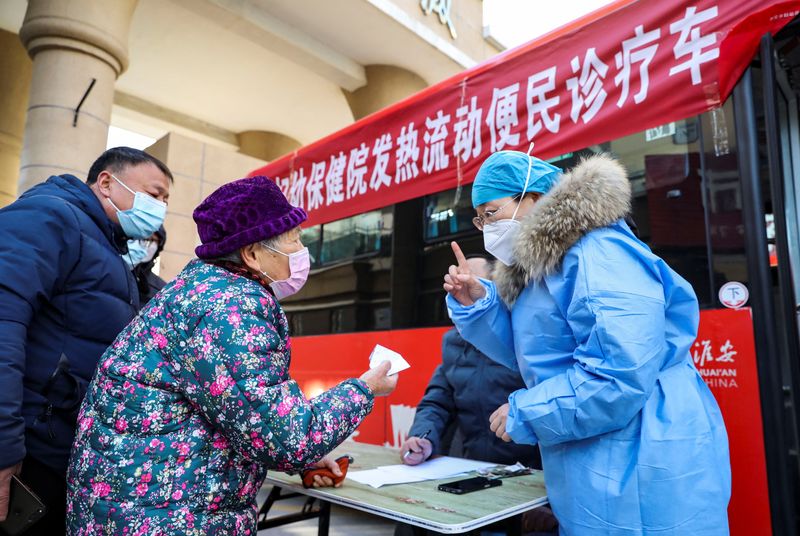China returns to work after lifting COVID restrictions
2022.12.26 00:47

China returns to work after lifting COVID restrictions
Budrigannews.com – On Monday, mask-wearing commuters from Beijing and Shanghai packed the subway trains. With millions of people across the country infected with the virus, which has spread largely unchecked, China’s two largest cities are getting closer to living with COVID-19.
In the face of protests and an expanding outbreak, President Xi Jinping this month ended the country’s zero-COVID policy of lockdowns and incessant testing after three years of ruthless curbs against the virus.
Residents and health professionals are concerned that China’s fragile health system is being overwhelmed and that the country’s statistics, which show that there were no new COVID deaths reported for the six days ending Sunday, do not accurately reflect the actual number of deaths.
There are indications that life is on track to return closer to normal after the initial shock of the policy change and a few weeks in which people in Beijing and Shanghai stayed inside, either dealing with the disease or trying to avoid it.
On Monday, as residents of the two cities commuting to work, some major traffic arteries in the two cities were jammed with slow-moving cars. Subway trains were packed in Beijing and Shanghai.
Lin Zixin, who lives in Shanghai and is 25 years old, stated, “I am prepared to live with the pandemic.” Lockdowns are not a long-term solution This year, 25 million people in China’s commercial hub were subjected to two months of bitter isolation under a strict lockdown that lasted until June 1 in an effort to prevent infections from spreading throughout the country.
In contrast to the atmosphere in April and May, when few people could be seen outside, Shanghai’s lively streets were a stark contrast.
Over the weekend, Shanghai’s Bund, a commercial district, hosted its annual Christmas market, which was well-liked by city dwellers. On Sunday, Christmas-themed queues formed for rides at Shanghai Disneyland and Beijing’s Universal Studios during the winter holiday season.
According to a report in the local newspaper The 21st Century Business Herald, this weekend’s number of trips to picturesque locations in the southern city of Guangzhou increased by 132% from the previous weekend.
“Now basically everyone has returned to a normal routine,” a Beijing resident named Han, who is 29 years old, stated. The nervousness has subsided.
China is the last major nation to treat COVID as an endemic disease. Global supply chains and trade were disrupted as a result of its containment measures slowing the $17 trillion economy to its lowest growth rate in nearly 50 years.
Analysts predict that the world’s second-largest economy will suffer further in the short term as the COVID outbreak spreads to manufacturing areas and employees become ill, before recovering next year.
NASDAQ: Tesla On Saturday, the company halted production at its Shanghai facility, announcing that most of the work there would be stopped in the last week of December. The business provided no justification.
World health experts are puzzled by the country with the most people in the world’s definition of COVID-related deaths, which now only includes pneumonia or respiratory failure caused by the virus.
According to state media, the country’s health care system has been put under a lot of stress, with staff being asked to work while sick and retired medical professionals in rural communities being hired again to help.
On Sunday, the provincial government of Zhejiang, a large industrial province near Shanghai with a population of 65.4 million, stated that it was dealing with approximately one million new COVID-19 infections on a daily basis, with the number expected to double in the coming days.
More Toyota car production has reached new high
State media reported that health authorities in the southeastern province of Jiangxi have stated that infections will peak in early January and that there may be additional peaks as people travel next month for Lunar New Year celebrations.
They warned that the outbreak would last three months and that about 80% of the 45 million people living in the province could become infected.
It has been estimated that up to 530,000 people in the eastern Shandong province city of Qingdao were infected on a daily basis.
In an effort to stop the spread of infectious diseases throughout hospitals, intensive care units and fever clinics have been rapidly expanding in cities across China.
The Beijing civil government has said the quantity of fever facilities in the city had expanded from 94 to very nearly 1,300, state media said. Shanghai has 2,600 of these kinds of clinics, and in order to assist, doctors have been transferred from less constrained medical departments.
Due to the fact that hundreds of millions of rural migrant workers are anticipated to return to their families for Lunar New Year, there are still concerns regarding the capacity of less-affluent cities in China to deal with an increase in severe infections.
Lin, a Shanghai resident, stated, “I am worried the flow of people will be huge… and the epidemic will break out again.”








